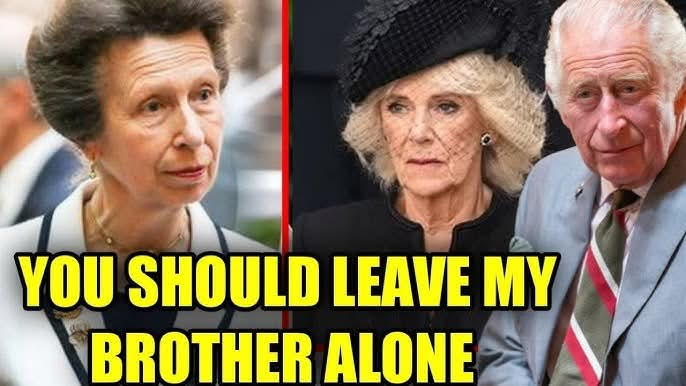NFL
Just in:Princess Anne warn!ng to Camilla to divorce king Charles or she will expose what happened to Diana…see more

Just in:Princess Anne warn!ng to Camilla to divorce king Charles or she will expose what happened to Diana…see more
A marriage that began as a fairy tale was to end as a nightmare for Prince Charles and Princess Diana. Their anguish was amplified by the unforgiving glare of the media spotlight that served as their battleground in a conflict that became known as “the war of the Waleses.”
The Crown’s companion documentary series Beneath the Crown (recorded before the passing of Queen Elizabeth II) takes a deep dive into the real events that are dramatized in the show’s fifth season. Join presenter Anita Rani in the video above to find out more about Diana’s iconic “revenge dress,” Charles’ intimate documentary and the battle for public affection.
Rebel Moon Freeform Banner
The publication of Andrew Morton’s bestselling book Diana: Her True Story in June 1992 proved to be the catalyst for an escalation in the rivalry between Charles and Diana. They’d previously put on a united front in public until the late 1980s, despite each side using their media connections to spread uncomplimentary stories about the other.
Morton’s book exposed Charles’ “special friendship” with Camilla Parker Bowles alongside other details of their unhappy marriage. Rumors of Diana’s secret involvement, confirmed to be true after her tragic death in 1997, served to compound the upset and embarrassment for the royal family.
Many UK stores such as Mohammed al-Fayed’s Harrods refused to stock the book, but it sold out on its first day of publication and became a cultural phenomenon. Prime Minister John Major was keen to dampen the fires, privately trying to negotiate an amicable uncoupling between the pair.
However, the announcement of Charles and Diana’s separation on Dec. 9, 1992 served to increase speculation about Charles’ alleged adultery. The following month saw the leak of the “Camillagate” tapes in the press, revealing intimate conversations to a stunned public.
On the ropes, Charles’ team fought back by enlisting British television presenter Jonathan Dimbleby to tell his side of the story through an extensive documentary. Dimbleby was given close access to Charles for over a year, interviewed more than 120 of his family members, friends and acquaintances and was supplied with 10,000 private letters and diaries. While Charles had no editorial control over the documentary, it supported his desire for a modern monarchy to be more transparent.
13 British Shows to Take You Straight Across the Pond
While Charles was being followed around by Dimbleby, Diana embarked on a series of solo trips supported by the British government, keen to harness her global popularity. She visited Mother Teresa’s hospice in India and British aid projects in Nepal, while championing women’s causes and domestic violence awareness back in Britain. By now a patron of more than 118 charities, her influence as a benevolent force was huge.
Yet the tabloid smear stories about her mental health didn’t go away, and the constant negative scrutiny took its toll. On Dec. 3, 1993, at London’s Hilton Hotel, Diana announced her imminent withdrawal from public life. The world was shocked. Was this victory for Charles’ side?
Princess Diana became a style icon almost as soon as she catapulted into the global spotlight in 1980. Played by Emma Corrin in Season 4 and Elizabeth Debicki in Seasons 5 and 6 of The Crown, Diana rocks everything from oversized sweaters to the little black dress more famously known as her ‘‘revenge dress.’’ There’s a look for every occasion. Flip through every outfit Diana’s ever worn on the series.
Months later, in June 1994, 13 million British viewers tuned in to watch Dimbleby’s hotly anticipated documentary Charles: The Private Man, the Public Role. Fears that it would be an airbrushed promotional tool were quickly quashed when, under probing questioning from Dimbleby, Charles made what was effectively an admission that he was unfaithful during his marriage.
The press lambasted Charles in a procession of hostile headlines. At the same time, there was extensive positive coverage for Diana’s well-timed public appearance at the Serpentine Gallery’s annual summer party in London. She wore an eye-catching outfit that would become known as her “revenge dress,” with photos splashed across front pages around the world.
More jostling for public support continued in the media, with Diana trying to top Charles’ Dimbleby documentary by taking part in an even more candid interview with Martin Bashir on BBC One’s Panorama in November 1995. The subsequent fallout was extensive and compelled Queen Elizabeth II to intervene.
With the credibility of the future king and existence of the monarchy at stake, she approved Charles and Diana’s request for a divorce. This definitive but highly controversial decision would bring the war of the Waleses to a close, enabling them to go their separate ways.
The significance of the queen’s actions was not lost on those who remember what divorce once meant to the monarchy and the role it played in putting her on the throne when King Edward VIII’s relationship with divorcée Wallis Simpson led to his abdication. It was a stark sign of how much times had changed in the intervening decades.












